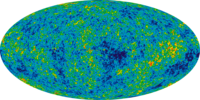
Photo from wikipedia
Galaxy clusters are a valuable source of cosmological information. Their formation and evolution depends on the underlying cosmology and on the statistical nature of the primordial density fluctuations. In this… Click to show full abstract
Galaxy clusters are a valuable source of cosmological information. Their formation and evolution depends on the underlying cosmology and on the statistical nature of the primordial density fluctuations. In this work we investigate the impact of primordial non-gaussianities (PNG) on the scaling properties of galaxy clusters. We performed a series of cosmological hydrodynamic N-body simulations featuring adiabatic gas physics and different levels of non-Gaussian initial conditions within the $\Lambda$CDM framework. We focus on the T-M, S-M, Y-M and Yx-M scalings relating the total cluster mass with temperature, entropy and SZ cluster integrated pressure that reflect the thermodynamical state of the intra-cluster medium. Our results show that PNG have an impact on cluster scalings laws. The mass power-law indexes of the scalings are almost unaffected by the existence of PNG but the amplitude and redshift evolution of their normalizations are clearly affected. The effect is stronger for the evolution of the Y-M and Yx-M normalizations, which change by as much as 22% and 16% when $f_{NL}$ varies from -500 to 500, respectively. These results are consistent with the view that positive/negative $f_{NL}$ affect cluster profiles due to an increase/decrease of cluster concentrations. At low values of $f_{NL}$, as suggested by present Planck constraints on a scale invariant $f_{NL}$, the impact on the scalings normalizations is only a few percent, which is small when compared with the effect of additional gas physics and other cosmological effects such as dark energy. However if $f_{NL}$ is in fact a scale dependent parameter, PNG may have larger positive/negative amplitudes at clusters scales and therefore our results suggest that PNG should be taken into account when galaxy cluster data is used to infer cosmological parameters or to asses the constraining power of future cluster surveys.
Journal Title: Monthly Notices of the Royal Astronomical Society
Year Published: 2017
Link to full text (if available)
Share on Social Media: Sign Up to like & get
recommendations!